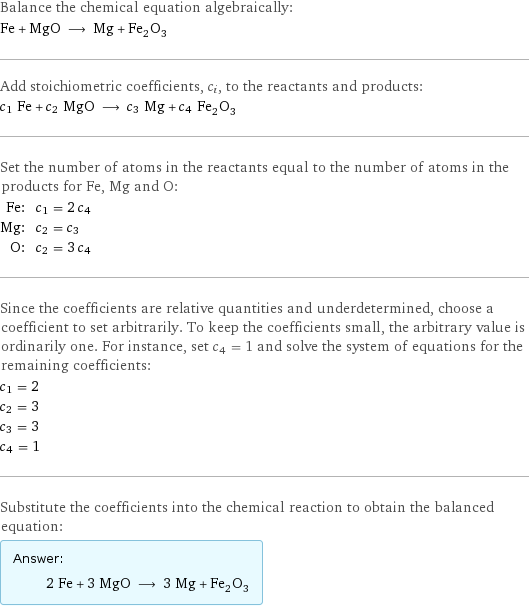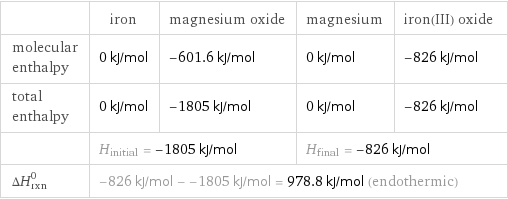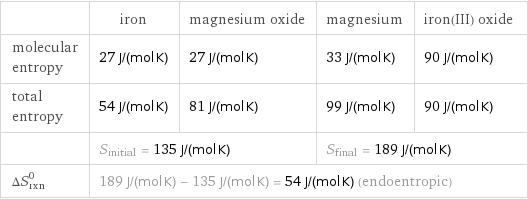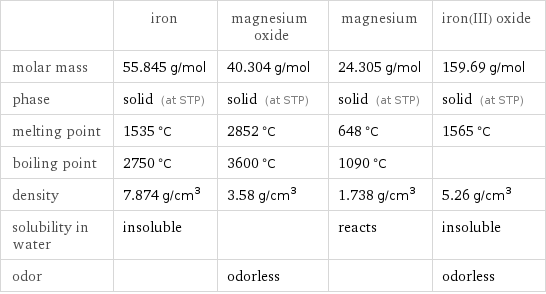Input interpretation

Fe iron + MgO magnesium oxide ⟶ Mg magnesium + Fe_2O_3 iron(III) oxide
Balanced equation

Balance the chemical equation algebraically: Fe + MgO ⟶ Mg + Fe_2O_3 Add stoichiometric coefficients, c_i, to the reactants and products: c_1 Fe + c_2 MgO ⟶ c_3 Mg + c_4 Fe_2O_3 Set the number of atoms in the reactants equal to the number of atoms in the products for Fe, Mg and O: Fe: | c_1 = 2 c_4 Mg: | c_2 = c_3 O: | c_2 = 3 c_4 Since the coefficients are relative quantities and underdetermined, choose a coefficient to set arbitrarily. To keep the coefficients small, the arbitrary value is ordinarily one. For instance, set c_4 = 1 and solve the system of equations for the remaining coefficients: c_1 = 2 c_2 = 3 c_3 = 3 c_4 = 1 Substitute the coefficients into the chemical reaction to obtain the balanced equation: Answer: | | 2 Fe + 3 MgO ⟶ 3 Mg + Fe_2O_3
Structures

+ ⟶ +
Names

iron + magnesium oxide ⟶ magnesium + iron(III) oxide
Reaction thermodynamics
Enthalpy

| iron | magnesium oxide | magnesium | iron(III) oxide molecular enthalpy | 0 kJ/mol | -601.6 kJ/mol | 0 kJ/mol | -826 kJ/mol total enthalpy | 0 kJ/mol | -1805 kJ/mol | 0 kJ/mol | -826 kJ/mol | H_initial = -1805 kJ/mol | | H_final = -826 kJ/mol | ΔH_rxn^0 | -826 kJ/mol - -1805 kJ/mol = 978.8 kJ/mol (endothermic) | | |
Entropy

| iron | magnesium oxide | magnesium | iron(III) oxide molecular entropy | 27 J/(mol K) | 27 J/(mol K) | 33 J/(mol K) | 90 J/(mol K) total entropy | 54 J/(mol K) | 81 J/(mol K) | 99 J/(mol K) | 90 J/(mol K) | S_initial = 135 J/(mol K) | | S_final = 189 J/(mol K) | ΔS_rxn^0 | 189 J/(mol K) - 135 J/(mol K) = 54 J/(mol K) (endoentropic) | | |
Equilibrium constant
![Construct the equilibrium constant, K, expression for: Fe + MgO ⟶ Mg + Fe_2O_3 Plan: • Balance the chemical equation. • Determine the stoichiometric numbers. • Assemble the activity expression for each chemical species. • Use the activity expressions to build the equilibrium constant expression. Write the balanced chemical equation: 2 Fe + 3 MgO ⟶ 3 Mg + Fe_2O_3 Assign stoichiometric numbers, ν_i, using the stoichiometric coefficients, c_i, from the balanced chemical equation in the following manner: ν_i = -c_i for reactants and ν_i = c_i for products: chemical species | c_i | ν_i Fe | 2 | -2 MgO | 3 | -3 Mg | 3 | 3 Fe_2O_3 | 1 | 1 Assemble the activity expressions accounting for the state of matter and ν_i: chemical species | c_i | ν_i | activity expression Fe | 2 | -2 | ([Fe])^(-2) MgO | 3 | -3 | ([MgO])^(-3) Mg | 3 | 3 | ([Mg])^3 Fe_2O_3 | 1 | 1 | [Fe2O3] The equilibrium constant symbol in the concentration basis is: K_c Mulitply the activity expressions to arrive at the K_c expression: Answer: | | K_c = ([Fe])^(-2) ([MgO])^(-3) ([Mg])^3 [Fe2O3] = (([Mg])^3 [Fe2O3])/(([Fe])^2 ([MgO])^3)](../image_source/46b4f2166d03f5793fcb4a5d64a938a6.png)
Construct the equilibrium constant, K, expression for: Fe + MgO ⟶ Mg + Fe_2O_3 Plan: • Balance the chemical equation. • Determine the stoichiometric numbers. • Assemble the activity expression for each chemical species. • Use the activity expressions to build the equilibrium constant expression. Write the balanced chemical equation: 2 Fe + 3 MgO ⟶ 3 Mg + Fe_2O_3 Assign stoichiometric numbers, ν_i, using the stoichiometric coefficients, c_i, from the balanced chemical equation in the following manner: ν_i = -c_i for reactants and ν_i = c_i for products: chemical species | c_i | ν_i Fe | 2 | -2 MgO | 3 | -3 Mg | 3 | 3 Fe_2O_3 | 1 | 1 Assemble the activity expressions accounting for the state of matter and ν_i: chemical species | c_i | ν_i | activity expression Fe | 2 | -2 | ([Fe])^(-2) MgO | 3 | -3 | ([MgO])^(-3) Mg | 3 | 3 | ([Mg])^3 Fe_2O_3 | 1 | 1 | [Fe2O3] The equilibrium constant symbol in the concentration basis is: K_c Mulitply the activity expressions to arrive at the K_c expression: Answer: | | K_c = ([Fe])^(-2) ([MgO])^(-3) ([Mg])^3 [Fe2O3] = (([Mg])^3 [Fe2O3])/(([Fe])^2 ([MgO])^3)
Rate of reaction
![Construct the rate of reaction expression for: Fe + MgO ⟶ Mg + Fe_2O_3 Plan: • Balance the chemical equation. • Determine the stoichiometric numbers. • Assemble the rate term for each chemical species. • Write the rate of reaction expression. Write the balanced chemical equation: 2 Fe + 3 MgO ⟶ 3 Mg + Fe_2O_3 Assign stoichiometric numbers, ν_i, using the stoichiometric coefficients, c_i, from the balanced chemical equation in the following manner: ν_i = -c_i for reactants and ν_i = c_i for products: chemical species | c_i | ν_i Fe | 2 | -2 MgO | 3 | -3 Mg | 3 | 3 Fe_2O_3 | 1 | 1 The rate term for each chemical species, B_i, is 1/ν_i(Δ[B_i])/(Δt) where [B_i] is the amount concentration and t is time: chemical species | c_i | ν_i | rate term Fe | 2 | -2 | -1/2 (Δ[Fe])/(Δt) MgO | 3 | -3 | -1/3 (Δ[MgO])/(Δt) Mg | 3 | 3 | 1/3 (Δ[Mg])/(Δt) Fe_2O_3 | 1 | 1 | (Δ[Fe2O3])/(Δt) (for infinitesimal rate of change, replace Δ with d) Set the rate terms equal to each other to arrive at the rate expression: Answer: | | rate = -1/2 (Δ[Fe])/(Δt) = -1/3 (Δ[MgO])/(Δt) = 1/3 (Δ[Mg])/(Δt) = (Δ[Fe2O3])/(Δt) (assuming constant volume and no accumulation of intermediates or side products)](../image_source/6bbe8ae3ce21b6c18caa0b782b6257a6.png)
Construct the rate of reaction expression for: Fe + MgO ⟶ Mg + Fe_2O_3 Plan: • Balance the chemical equation. • Determine the stoichiometric numbers. • Assemble the rate term for each chemical species. • Write the rate of reaction expression. Write the balanced chemical equation: 2 Fe + 3 MgO ⟶ 3 Mg + Fe_2O_3 Assign stoichiometric numbers, ν_i, using the stoichiometric coefficients, c_i, from the balanced chemical equation in the following manner: ν_i = -c_i for reactants and ν_i = c_i for products: chemical species | c_i | ν_i Fe | 2 | -2 MgO | 3 | -3 Mg | 3 | 3 Fe_2O_3 | 1 | 1 The rate term for each chemical species, B_i, is 1/ν_i(Δ[B_i])/(Δt) where [B_i] is the amount concentration and t is time: chemical species | c_i | ν_i | rate term Fe | 2 | -2 | -1/2 (Δ[Fe])/(Δt) MgO | 3 | -3 | -1/3 (Δ[MgO])/(Δt) Mg | 3 | 3 | 1/3 (Δ[Mg])/(Δt) Fe_2O_3 | 1 | 1 | (Δ[Fe2O3])/(Δt) (for infinitesimal rate of change, replace Δ with d) Set the rate terms equal to each other to arrive at the rate expression: Answer: | | rate = -1/2 (Δ[Fe])/(Δt) = -1/3 (Δ[MgO])/(Δt) = 1/3 (Δ[Mg])/(Δt) = (Δ[Fe2O3])/(Δt) (assuming constant volume and no accumulation of intermediates or side products)
Chemical names and formulas

| iron | magnesium oxide | magnesium | iron(III) oxide formula | Fe | MgO | Mg | Fe_2O_3 name | iron | magnesium oxide | magnesium | iron(III) oxide IUPAC name | iron | oxomagnesium | magnesium |
Substance properties

| iron | magnesium oxide | magnesium | iron(III) oxide molar mass | 55.845 g/mol | 40.304 g/mol | 24.305 g/mol | 159.69 g/mol phase | solid (at STP) | solid (at STP) | solid (at STP) | solid (at STP) melting point | 1535 °C | 2852 °C | 648 °C | 1565 °C boiling point | 2750 °C | 3600 °C | 1090 °C | density | 7.874 g/cm^3 | 3.58 g/cm^3 | 1.738 g/cm^3 | 5.26 g/cm^3 solubility in water | insoluble | | reacts | insoluble odor | | odorless | | odorless
Units
